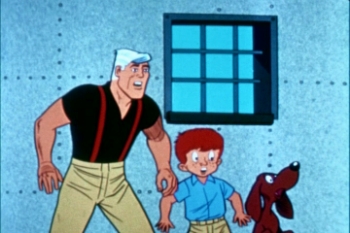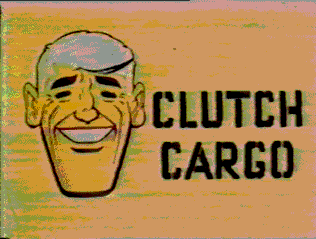Clutch Cargo was an animated show produced by Cambria Productions that debuted on March 9, 1959, as a syndicated series available to local stations around the country. It stayed on the air through the early 1970’s, and could be seen on as many as 65 stations nationwide.
The stories centered around Clutch Cargo, a writer and airplane pilot with a muscular build, white hair and rugged good looks, who traveled the world (and even outer space) on dangerous assignments. Clutch was accompanied by his young ward Spinner and his pet dachsund, Paddlefoot, and sometimes by Clutch’s grizzled, pith-helmeted friend Swampy.
What made Clutch Cargo special was its unique style of animation, if you could call it that. In fact, the animation on this series was so limited that it looked more like a series of panels from a comic book. To save money on production, Cambria developed some clever but cheesy-looking ways to simulate motion. If there was an explosion, they would shake the camera or the drawing of the scene to make it look like the earth was trembling. If there was a fire, they would blow real smoke across the drawing. When characters had to walk or run, they would only be shown from the waist up, to save money and time that would have been spent on showing the character’s legs moving.
But the animation technique that Clutch Cargo is best-remembered for is the way that it showed characters talking. Using a patented process called Synchro-Vox, the producers filmed the mouths of the live actors speaking the characters’ lines and then superimposed the film of the actors’ moving lips onto the motionless drawings of the characters’ faces. This resulted in a weird-looking and kind of creepy effect that, combined with the other forms of primitive animation in the series, gave it a truly unique look and feel. You can still see the Synchro-Vox technique in use today, most notably in the opening to Spongebob Squarepants. Conan O’Brien used the technique quite often in segments on his former late-night TV show.
 Despite, or perhaps because of, its crude animation techniques, Clutch Cargo had a certain charm that helped make it a very successful series. It was cleverly written and beautifully drawn. Its musical soundtrack was as limited, and yet as inventive within those limitations, as the animation. Jazz musician Paul Horn provided the score using nothing more than bongo drums, a vibraphone, and a flute.
Despite, or perhaps because of, its crude animation techniques, Clutch Cargo had a certain charm that helped make it a very successful series. It was cleverly written and beautifully drawn. Its musical soundtrack was as limited, and yet as inventive within those limitations, as the animation. Jazz musician Paul Horn provided the score using nothing more than bongo drums, a vibraphone, and a flute.
In all, 52 Clutch Cargo adventures were produced and then serialized in five five-minute chapters each. The first four chapters naturally ended in cliffhangers, with the fifth chapter concluding the adventure. This format allowed local stations to run one chapter a day on weekdays, then recap all five chapters in a half-hour Saturday show. You can see all five chapters of one continuing episode below.
Clutch Cargo was a very popular show whose content and style influenced many animated series that came later. It may have been the first television cartoon in the U.S. to emphasize adventure rather than humor. Its emphasis on dramatic action in exotic locales and its low-budget animation style can be seen in such later series as Jonny Quest, Space Ghost, and the Mighty Mightor.
There are some great Clutch Cargo compilations available on DVD, including Clutch Cargo – The Complete Series (Vol. 1), Clutch Cargo – The Complete Series (Vol. 2), and the Clutch Cargo Cartoon Collection (Vol. 1).


Recent Comments